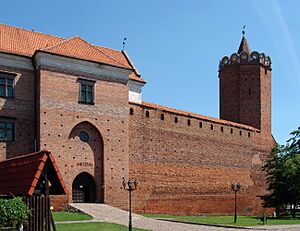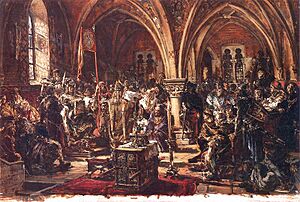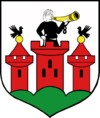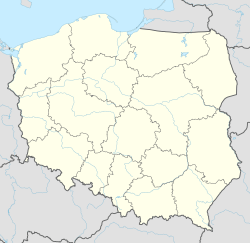Łęczyca facts for kids
Quick facts for kids
Łęczyca
|
||
|---|---|---|
| Królewskie Miasto Łęczyca | ||

Łęczyca Royal Castle
|
||
|
||
| Country | ||
| Voivodeship | Łódź | |
| County | Łęczyca | |
| Gmina | Łęczyca (urban gmina) | |
| Area | ||
| • Total | 9.0 km2 (3.5 sq mi) | |
| Population
(31 December 2021)
|
||
| • Total | 13,587 | |
| • Density | 1,510/km2 (3,910/sq mi) | |
| Time zone | UTC+1 (CET) | |
| • Summer (DST) | UTC+2 (CEST) | |
| Postal code |
99-100
|
|
| Car plates | ELE | |
| Website | http://www.leczyca.info.pl | |
Łęczyca (pronounced wen-CHI-tsa) is an old and important town in central Poland. About 13,500 people live there. It is located in the Łódź Voivodeship and is the main town of Łęczyca County. Łęczyca is also known as the Royal Town of Łęczyca because of its long history.
Contents
What's in a Name?
The name Łęczyca probably comes from an old Slavic tribe called the Leczanie. This tribe lived in central Poland a very long time ago.
Some people think the name comes from an old Polish word, łęg. This word means a swampy or wet plain.
In old Latin papers, Łęczyca was called by names like Lonsin or Lucic. An Arab mapmaker in 1154 called it Nugrada. He listed it as one of Poland's main towns, like Kraków and Gniezno.
Where is Łęczyca Located?
Łęczyca is right in the middle of its county. It covers an area of about 9 square kilometers (3.5 square miles).
In the past, Łęczyca was the capital of a large area called the Łęczyca Land. This area later became the Łęczyca Voivodeship, which was like a province. The exact center of Poland is actually very close to Łęczyca!
A Look Back in Time: History of Łęczyca

Łęczyca is one of Poland's oldest cities. It was first mentioned in the 1100s. A very important event happened here in 1180: the first recorded meeting of the Sejm, which is Poland's parliament.
In 1229, during a time when Poland was split into smaller parts, Łęczyca became the capital of the Duchy of Łęczyca. This duchy was a small kingdom. Later, in the early 1300s, it became the capital of the Łęczyca Voivodeship. This was an important part of the Polish Kingdom until the late 1700s. Łęczyca was also a special royal city, meaning it belonged directly to the Polish king.
Łęczyca was a very important city for many centuries. It received special town rights, called Magdeburg rights, before 1267. These rights gave the town more freedom and helped it grow.
However, in 1331, the Teutonic Knights attacked and destroyed much of the city. Many buildings, including two churches, were burned. But a few decades later, King Casimir the Great ordered the city to be rebuilt with strong walls. He also had a Royal Castle built to protect it.
The Royal Castle
The castle in Łęczyca was built by King Casimir the Great. It stood on a small hill and was protected by a moat filled with water from the Bzura river. The castle was made of red brick with stone foundations. It had a tall, 10-meter (33-foot) wall and a tower. Inside, there was a two-story building where the Royal Council often met. The basement of the gate tower was even used as a prison!
In 1964, the castle was carefully restored. Today, it houses the Museum of the Land of Łęczyca.
The castle was a royal home and a seat for local leaders. In 1406, the Teutonic Knights burned it again. But it was rebuilt so quickly that by 1409, King Władysław II Jagiełło held an important meeting there to plan for war against the Knights.
After the famous Battle of Grunwald in 1410, many important Teutonic prisoners were held at the castle for ransom. The Polish parliament (Sejm) met here four times in the 1400s. In 1420, a group from Bohemia even offered the Czech crown to King Jagiełło at the castle! In 1433, an important peace agreement, the Truce of Łęczyca, was signed in the city.
The castle was also King Casimir IV Jagiellon's headquarters during the Thirteen Years' War (1454–66).
Łęczyca's importance lessened after the Swedish invasion in the mid-1600s. The castle was taken over, and most of the city was destroyed again. It struggled until the late 1700s.
World War II in Łęczyca
During World War II, when Germany invaded Poland in 1939, Łęczyca faced terrible times. German soldiers executed many Polish people. The town was taken over by Nazi Germany.
The Germans forced many Polish families to leave their homes. Young people were sent to work in Germany, and older people and children were sent to other parts of Poland. Their homes were given to German settlers.
Jewish people had lived in Łęczyca for hundreds of years. In 1939, there were over 4,000 Jewish residents. The Germans treated them very cruelly. They created a special area called a ghetto, where Jewish people were forced to live. No one was allowed to leave the ghetto. Life there was very hard, with little food and many diseases.
In April 1942, the remaining Jewish people, about 1,700 of them, were sent to a camp where they tragically died.
After the war, Łęczyca became part of the new Polish state.
Famous Places to See
Łęczyca has many interesting historical sites:
- Royal Castle: The castle you read about, rebuilt after 1964.
- Church of St Andrew the Apostle: This church was first built in 1425.
- Dominican monastery: This old monastery was used as a prison for a long time, from 1799 until 2006.
- Cistercian church and monastery: These beautiful buildings were constructed between 1636 and 1643.
- Defensive walls of Łęczyca: You can still see parts of the old town walls. They were once 1,150 meters (3,770 feet) long and 7 meters (23 feet) high! The town's layout still shows its medieval design.
A few kilometers away, you can find the old Collegiate church and the remains of a medieval settlement called Tum.
Sports
Łęczyca has a local football (soccer) team called Górnik Łęczyca. They play in the lower leagues.
Famous People from Łęczyca
Many important people have connections to Łęczyca, including:
- Władysław I the Elbow-high: A Polish king.
- Władysław II Jagiełło: Another Polish king.
- Zygmunt II August: A Polish king.
- Rabbi Shlomo Ephraim Luntschitz (Lenczyk): A famous rabbi.
- Rabbi Meïr Löb ben Jehiel Michel Weiser Malbi"m: Another famous rabbi.
- Józef Szczepański: A poet and soldier.
Sister Cities
Łęczyca has friendly relationships with four other cities around the world:
 Rillieux-la-Pape, France
Rillieux-la-Pape, France Penzlin, Germany
Penzlin, Germany Volodymyr, Ukraine
Volodymyr, Ukraine Rypin, Poland
Rypin, Poland
Images for kids







